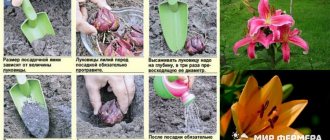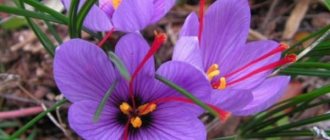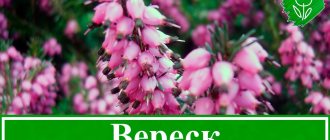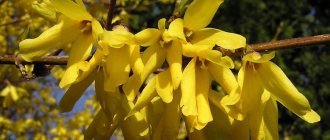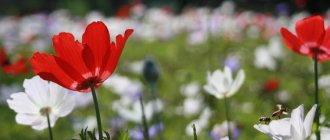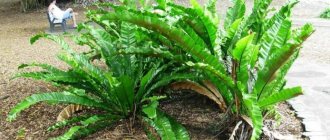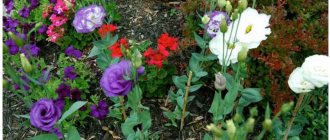Surfinia varieties
There are more than 20 species of this crop and many varieties of surfinia.
Ampelnaya
Surfinia Ampelnaya perennial
Ampelnaya is a perennial plant grown in gardens. It spends the winter period in basements, without leaves (they are cut off before sending the surfinia to rest); in early spring, buds and foliage form on it.
Yellow
Surfinia Yellow
Yellow is the first selective variety of an ampelous species, characterized by early and long flowering. The number of buds is numerous, the color ranges from light to dark yellow.
Burgundy
Surfinia Burgundy
Burgundy is a branched plant on which wine-colored flowers appear in large numbers, which disappear only with frost.
Double Purple
Surfinia Double Purple
A fast-growing variety, 20 cm tall, characterized by its resistance to excess moisture. There are many flowers on the bush, the color is bright purple;
Hot Pink
Surfinia Hot Pink
Hot Pink - has large inflorescences in two shades (pink background with bright crimson stripes);
Table White
Surfinia Table White
Table White - flowering lasts more than 5 months, the flowers are similar to bells and have a snow-white hue;
Red
Surfinia Red
Red - small bushes in the shape of a ball, characterized by long flowering, the buds have a bright red hue. The species is capricious and demanding in maintaining optimal growing conditions.
Surfinia: varieties of ideal ampel
Classic varieties of surfinia
Classic varieties of surfinia are early flowering plants, with powerful and long stems, characterized by high growth vigor.
Surfinia® White – grows a bush with a diameter of 1-1.5 meters, drooping stems, growing in a horizontal plane from an early age. It blooms a huge number of snow-white flowers with a soft yellow throat. Surfinia White flower has a classic “petunia” shape, medium size.
Surfinia White
Surfinia® Red is a variety of surfinia that forms dense flowering balls in baskets, behind which the greenery is practically invisible. The bright red flowers are quite large, the bush shape is compact.
Surfinia Red
Surfinia® Deep Red is the winner of the “bronze” American Garden Award in 2012 and a host of other awards in the field of floriculture. This is the first time that breeders have managed to obtain such a deep red color on petunias.
Surfinia Deep Red
Surfinia® Blue is an early flowering plant with large blue flowers. Long flexible branches form a real blue waterfall, especially impressive in hanging baskets.
Surfinia Blue
Surfinia® Blue Vein – interesting surfinia flowers with dark blue, almost inky, veins and throat. An excellent ampel with a fragrant aroma that intensifies in the evening.
Surfinia Blue Vein
Surfinia® Velvet Blue – Velvety blue flowers with wavy edges will brighten up any hanging basket.
Surfinia Velvet Blue
Surfinia® Yellow is a fast-blooming surfinia with soft yellow flowers. The first variety of ampelous yellow petunias, resistant to cold.
Surfinia Yellow
Surfinia® Burgundy is a massive bush that branches vigorously and produces many large flowers of a rich wine color.
Surfinia Burgundy
Surfinia® Sweet Pink is a classic, fast-blooming surfinia. Soft pink flowers with darker veins create a luxurious, lush cloud.
Surfinia Sweet Pink
Surfinia® Hot Pink is a surfinia that produces large, deep pink flowers. Bright crimson veins running from the throat to the wavy edge of the flower make this plant even more attractive in the eyes of gardeners.
Surfinia Hot Pink
Surfinia Table series
Surfinias from the Table series have less amplitude than classic varieties. They are distinguished by more compact, densely clustered bushes. The flowers of many varieties of Table have an unusual shape: elongated, resembling bells.
Surfinia® Table White is one of the most spectacular surfinias, often becoming a favorite in private collections of petunia breeders. Small snow-white flowers look like bells and densely cover the entire bush. It blooms without a break throughout the warm season, starting in late spring.
Surfinia Table White
Surfinia® Table Yellow – has an unusual lemon coloring of flowers with bright yellow veins, which is unusual for surfinias. Due to the small size of the flower, it looks very touching and easily combines with other ampels, for example, with calibrachoa.
Surfinia Table Yellow
Surfinia® Table Pink Morn is a very early, fast growing variety. The flowers are soft pink with a white throat. A real pink morning in a flower garden!
Surfinia Table Pink Morn
Surfinia® Table Dark Red is a compact bush with dark red flowers. Very early flowering, lasting until late autumn.
Surfinia Table Dark Red
Surfinia® Table SalmonVein is a small-flowered surfinia that is completely covered in “salmon” flowers in season. The growth vigor of the bush is medium, the shape is compact.
Surfinia Table Salmon Vein
Surfinia varieties Double
Surfinia Double varieties are ampels with large double flowers. In terms of the abundance of flowering, they are slightly inferior to the classic varieties, but at the same time they look unusually decorative.
Surfinia® Double White is a plant with large, densely double white flowers. It branches along the entire length of the shoots, striking the imagination with increased flowering.
Surfinia Double White
Surfinia® Double Purple - double surfinia with purple flowers that do not suffer from summer rains. A powerful, branched plant that develops in a horizontal plane. The branches can reach 1 m, the height is only 10 -15 cm.
Surfinia Double Purple
Surfinia® Double Red - has very beautiful red flowers, but requires more care than other varieties in the Double series. If agricultural practices are violated, growth may be inhibited.
Surfinia Double Red
Surfinia® Double Pink – trailing, increase in average power. Forms a compact bush with many light pink double flowers.
Surfinia Double Pink
New varieties of surfinia with unique qualities
Several more varieties of surfinia that have unique qualities and are distributed under the Specials series.
Surfinia® Amethyst is a trailing patio plant that requires no shaping and grows in a dense green head. The flowers are deep purple with a white throat. It has a pleasant aroma, which becomes especially strong in the evening and spreads several meters from the plant.
Surfinia Amethyst
Surfinia® Picotee Blue is a dense bush with long branches. The flowers of Surfinia Pikoti are unusually elegant - bright blue with a white rim. Characterized by early and very abundant flowering.
Surfinia Picotee Blue
Surfinia® Green Edge Pink is an innovative variety designed to expand the color range of the Surfinia family. A pink flower with soft green edges - this has never happened before! The bush is compact with powerful branching and forms a thick head on its own.
Surfinia Green Edge Pink
Sowing surfinia seeds
Most often, surfinia is grown at home from seeds. For these purposes, it is necessary to select high-quality seed, paying special attention to the shelf life and integrity of the packaging.
Surfinia is sown in early spring in the following sequence:
- Preparing the container – any containers or small pots will do.
- Preparation of the substrate - peat tablets, or sand with peat. The soil for seedlings must be breathable.
- Arrangement of a drainage system made of foam balls, pebbles or expanded clay.
Surfinia growing from seeds
- Due to its small size, planting material should not be buried in the ground. Several seeds are placed on moist soil and covered with film.
- The pots are opened daily for ventilation.
- Watering is carried out from a spray bottle as the soil dries out (it should remain slightly moist).
- The pots should be installed in a designated place where the air temperature reaches at least 20 degrees.
- The first shoots should appear in 15-20 days. At this time, the roots must be sprinkled with fried sand to protect them from rotting and strengthen them, and the protective film must be removed.
- Transplanting one specimen into pots is done when the plant has 2 leaves.
Growing from seeds
Among the various methods of propagating surfinia, growing from seeds is considered the most popular. This is due to the simplicity of the procedure and the high germination rate. High-quality planting material can be collected directly from home bushes or purchased at a florist stall. In the latter case, regular and coated seeds are offered. If the former produce poor seedlings due to low quality, the latter need moderate watering from the moment of planting, otherwise their shell will not be able to completely open.
Only fresh raw materials are suitable for sowing into the soil, so at the acquisition stage you should pay attention to the shelf life and method of planting different types of seeds. The pelleted version is more demanding in terms of conditions and timing.
To plant a crop, you should perform the following steps::
Prepare the pot with light and loose soil that can allow water and air to pass through. Peat, which is pre-mixed with sand, as well as peat tablets can be used as a filler.- It is no secret that the size of surfinia seeds is relatively small, so it is customary to sow them on the surface without sprinkling a lump of earth on top. At the same time, a comfortable greenhouse is set up above the seedlings, for example, made of plastic film or glass.
- A spray bottle is used to water young plants. Also, at an early stage of their development, periodic ventilation is required. The bottom of the container used must allow water to pass through, otherwise stagnation of moisture will lead to not the most pleasant consequences. Excess water should not accumulate at the bottom, but, on the contrary, should calmly come out.
- The container with seedlings should be in a warm, well-lit room with a temperature range of 20-22 degrees Celsius. It is important to protect surfinia from contact with direct sunlight.
- If the previous steps were performed correctly, then the first shoots should hatch in 14 days. At this time, you need to add a small amount of river sand to the container, which will protect the plants from root rot and provide additional stimulation for their growth. As soon as the seedlings grow a little, the procedure can be repeated.
Surfinia cuttings
Reproduction of surfinia by cuttings
Petunia surfinia can also be propagated by cuttings. To do this you need:
- At the beginning of autumn you need to cut off a large specimen of the plant.
- Plant it in a fertile substrate.
- Cover with a jar or film to create the required level of humidity and heat.
- When the soil dries out, it must be moistened, but moisture should not be retained.
- The greenhouse should remain in place until new leaves form on the plant.
- A viable bush can be observed already in mid-spring, at which time it is transplanted to the place where it will grow on a permanent basis.
Growing Surfinia
The main difference from classic petunia is that surfinia practically does not produce seeds and is propagated by cuttings. At home, propagation by seeds becomes impossible, but companies selling plants have already learned how to “get” seeds and offer them for open sale. If you decide to propagate the ampelous beauty, you have two ways: pinch off a shoot and plant it, or sow purchased seeds for seedlings. Let's consider both methods and find out their secrets.
Growing from seeds
To purchase seeds, you should contact a specialized store with a good reputation, where you will be confident in the quality of the planting material. When purchasing, pay attention to the maternal hybrid F 1, it means the first generation of the hybrid. Do not ignore the expiration date of seeds.
Sowing seeds for seedlings begins at the end of February. To do this, take a nutritious soil composition, lightly moisten it and carefully sow the seeds. For good germination, the box should be covered with film to create a greenhouse effect. After this, the box is left in a warm, well-lit room and opened daily to ventilate and remove condensation.
As the soil dries, it is moistened with a sprayer, but waterlogging should not be allowed, otherwise mold or mildew will appear. At the right temperature and good seed material, the first shoots will appear in 1-2 weeks.
When the sprouts appear, the film is removed. To feed young plants, you can use a solution of chicken manure; it is added every 2 weeks in small portions, diluted 1:15. Superphosphate is recommended as a mineral fertilizer; it is alternated with organic fertilizer - once every 10-14 days.
Soil for seedlings
Seedlings will feel good in the following earthen composition:
- 1 part peat and vermicompost.
- 2 parts of garden soil.
- Vermiculite - for loosening.
- Wood ash or lime to normalize soil acidity.
Seedling care
After the first shoots appear, the box is moved closer to the light source, sprayed and fed daily, according to the schedule. When the sprouts have 3 leaves, they are transplanted into separate pots or glasses.
If you plan to grow in a cache-pot or pot, then the seedlings can be immediately planted for permanent residence. To grow a slender and beautiful plant, the seedlings are placed on the windowsill and turned towards the light if the sprouts begin to droop.
Planting seedlings in open ground is carried out in May-June, when there is no risk of spring frosts and the air temperature has reached 18-20 degrees.
Growing by cuttings
For year-round plant growth, bushes can be taken from cuttings, so you will get beautiful, lush flowers without the hassle of growing seedlings. At the end of August or beginning of September, healthy and strong shoots are selected, cut into cuttings and rooted. To do this you will need a pot with fertile soil and a plastic bottle.
The cut of the cutting is dipped in a growth stimulator and planted in prepared, moistened soil, covered with a plastic glass or cut bottle. Water as needed.
New plants are placed in a room with an air temperature of 23 degrees and additional lighting is turned on to extend daylight hours to 16 hours. Young shoots are sprayed and watered as the soil dries, fertilizing is carried out in late autumn and spring.
Seedling care
Growing surfinia seedlings
Since surfinia loves light, seedlings need good lighting. If necessary, you need to create artificial lighting so that the adult plant can subsequently bloom profusely.
When leaves appear on young seedlings, it is important to pinch them in a timely manner, removing the top pair of leaves. This procedure will stimulate the growth of lateral layers so that the bush will be lush and branchy in the future.
Planting in open ground is carried out at the end of spring. To do this, it is prepared, which consists of watering and fertilizing. A complex fertilizer must contain all the necessary substances, but potassium should be the predominant component. Fertilizer for seedlings is diluted in a weaker concentration than for adult plants, gradually bringing the indicators to those indicated on the package. Fertilizers must be applied every 2 weeks.
Important . You can create a colorful flowerbed in which all the surfinia flowers will highlight each other by alternating shades or combining colors.
Planting Tips
As for picking, it is carried out for those plants that already have two full leaves. At this stage, they must be transferred to larger pots and placed in such a way that neighboring young specimens do not disturb their growth. When growing seedlings in peat tablets, diving is not necessary, since each seedling is placed in a separate plate.
If the plant produces 5-7 adult leaves and the root system becomes strong enough, it can be moved to open ground, to a flowerbed or hanging flowerpot, to a balcony or terrace.
At the same time, the florist can realize his imagination and carry out combinations with different colors and shapes of bushes, creating more rich ensembles. Seeds for seedlings are placed in the ground in late March - early April . If planting is carried out in open soil, then it is important to make sure that the air temperature will be consistently high and the soil will warm up by 3-4 centimeters. As a rule, this happens at the end of May - beginning of June.
During this period, the seedlings are regularly fed. Fertilizing begins within 3-4 weeks from the moment the first shoots peck, adding fertilizers to the ground along with water.
Complex compositions for flowers with low concentrations are used. As the culture develops, the concentration increases.
Conditions for surfinia
Surfinia ampelous can grow fruitfully and delight its owners with long-lasting flowering only if there is a constant supply of sunlight. It is equally important to protect the plant from the influence of winds so that the shoots do not get confused with each other and do not break.
Attention! Raindrops falling on the inflorescences can also harm surfinia. Therefore, it is necessary to create protection from precipitation.
Location and lighting
The Petuniaceae family, including Surfinia, are demanding of sunlight. Seedlings deprived of lighting will have weak sprouts and a small number of flower ovaries. The best option is 10-12 hours of daylight.
In a flowerbed, the plant can thrive on sunny sides with minimal shading (east, south, southeast, southwest). If you plant the plant in a darker place, this may affect the quality and duration of flowering.
The soil
The composition of the soil plays an important role in growing and caring for surfinia. If seedlings grow on peat tablets, then an adult plant needs more fertile soil. Surfinia will develop productively on loam with an acidity of 5-6 pH, as well as on sandy substrates. The main condition for ideal cultivation is space and fertile soil with all the necessary microelements and vitamins.
How is surfinia different from petunia?
Ampelous petunia - growing in hanging pots
Surfinia ampelous is a hybrid of petunia. How surfinia differs from petunia is clear only to experienced gardeners. Very often, surfinia is compared with ampelous petunia. However, surfinia is distinguished from its parent by a number of advantages.
They can be distinguished by their abundant and luxurious flowering. Also, the difference is that the buds of surfinia hang down, and the inflorescence itself is endowed with dark or light eyes. Another difference is the smell. It smells pleasant, and the aroma intensifies in the evening.
Surfinia hybrid petunia of Japanese selection
This flower is the fruit of long experiments by Japanese breeders. Back in the 1970s, Suntory carried out work to adapt trembling petunia to a wide variety of weather conditions. As a result, a variety was bred, which was called “surfinia”. In a fairly short period of time, it gained worldwide popularity, and there were several reasons for this:
- the flower is quite resistant to adverse weather, or more precisely to rain and wind. However, it is not worth exposing the flower to constant exposure to cold water and temperature;
- compared to petunia, it is less susceptible to diseases;
- long flowering period. It is also worth noting that it is more lush and active;
- variety of shades (white, pink, red, yellow, purple, etc.);
- vegetation occurs faster.
"Bright bloom of Surfinia"
When purchasing surfinia to decorate your garden, you should carefully study the rules of cultivation and care. Sulfinia ampelous, which may at first seem difficult to care for and grow at home, grows into a lush and amazingly beautiful bush that looks like a bright waterfall of terry buds.
Hardening before planting in open ground
Hardening of the plant is the basis for the further growth of surfinia. In order for seedlings to adapt to new conditions, they need to be prepared. To do this, young sprouts are taken outside for several hours, leaving them in a dark place where there is no risk of direct sunlight hitting the leaves.
Since hardening is carried out at the end of May, there is no threat of daytime frosts, but precipitation is quite likely. A small amount of rainwater will not harm the seedlings, but it is important to monitor the level of moisture and the strength of the rain, because weakened plants can break under the pressure of a downpour.
Planting seeds
Growing and caring for any plant are the most important processes in this matter. Since it depends on them what the flower will be like in the future. Surfinia propagation occurs using seeds, or you can cut off a cutting from an adult plant and plant it immediately. If this is not done in the first two hours after cutting, then its chance of taking root drops sharply.
Read the article about growing petunia
Growing from seeds takes much longer and requires patience and care in the process. And the result obtained at the end will pleasantly surprise you. Seeds should be planted in February or March. You can buy soil at a specialty store or make your own mixture from:
- Sod land;
- Leafy soil;
- Humus;
- Sand.
Before planting the seed, you need to sift the top layer of the substrate, which is about 1 centimeter. This is done in order to create more favorable conditions for further seed germination. A day before sowing, it is recommended to water the soil generously so that by the time of planting it is saturated with moisture.
As for the seeds, they are very small and therefore, before planting them in the ground, they need to be mixed with sand. You can use seeds in a shell and this will make sowing much easier for you.
Now you need to scatter all the seeds evenly over the surface, but do not cover them with the mixture or press them in. You just need to spray the soil with water from a spray bottle, and then cover the container tightly with film or glass.
In the next 5-7 days, the container with seeds should be kept in partial shade at a temperature of 20-23 degrees Celsius. Spray the soil in which the seeds germinate daily to keep it slightly moist. If you see that the soil quickly becomes dry within a day, then this procedure can be carried out two or three times a day.
You may also be interested: Secrets of caring for roses in spring
After a week, you will see small shoots begin to appear on the surface. From this moment, the seedlings need to begin to be ventilated, that is, remove the glass or film for several hours. Do not forget that surfinia loves moisture very much and therefore regular watering will help you grow full-fledged seedlings, which in the future will give you excellent, lush flowering.
Planting surfinia in open ground
Surfinia in a flowerbed
Surfinia looks great in hanging flowerpots, tall containers or in a flowerbed. However, when planting, you need to take into account the ability of surfinia to quickly increase the vegetative mass and root system. In order for the plant to develop and bloom magnificently, it should not be crowded.
When planting in pots or containers, the container volume should be selected at a rate of at least 5 liters per plant. When planting surfinia in a flowerbed, maintain a distance between plants of at least 40 cm. Closer planting will provoke rot and disease.
The soil for planting surfinia must be prepared in advance. If the soil is dense, add sand (1 bucket per 1 sq. m.), the soil should be light and loose. Fill 1/2 bucket with humus per 1 sq. m.), ash (1 cup per 1 sq. m.) and complex fertilizer in granules (1 tbsp. per 1 sq. m.). Mix everything well.
For flower pots and containers, soil is mixed from garden soil (2 buckets), humus (1/2 bucket), sand (1/2 bucket), ash (1 cup) and complex fertilizer (1 tbsp.)
Care
The main work associated with caring for the plant occurs during its flowering period. At this point, it is important to observe 3 main points:
- watering;
- lighting;
- application of fertilizers.
Not only the number of flowers on the bush, but also the duration of their flowering depends on how carefully all the recommendations are followed.
Watering
Maintaining an optimal level of moisture in the soil is the main condition for good growth of surfinia. It does not require a large amount of water, so it is recommended to water it in small portions, but quite often. If the plant is in hanging flowerpots, it can be sprayed with a spray bottle. The main thing is to use settled water that is at room temperature.
Important. Watering is carried out when there is no sunlight - early in the morning or during sunset.
Feeding
Periodic feeding is also important for surfinia. In order for it to bloom normally, the bushes need to be fed with potassium. You can buy special fertilizers in the store, or prepare them yourself. The main thing is to observe the recommended proportions, and apply along with watering.
Diseases and pests
The main difference between surfinia is its resistance to diseases and pests. But, like all plants, it cannot be completely protected from the risk of pathologies:
- fungal diseases most often develop due to non-compliance with watering rules and increased acidity levels;
- Spider mites are the most dangerous enemy of the Petunia family, which infects leaves and leads to the death of the flower. To get rid of it, it is necessary to treat the plant with special preparations or ordinary soapy water;
- late blight can also become one of the causes of death of surfinia; this can be prevented by using a solution of copper sulfate or preparations containing copper.
Features and varieties
Surfinia is one of the varieties of petunia. This is a kind of hybrid that is much better than its predecessor. Many novice gardeners do not know the difference between petunia and surfinia, and believe that they are the same flower. Surfinia has a huge number of shades, in addition to yellow and orange, and the flowers themselves can be either simple or semi-double. This variety was bred in Japan, and then spread throughout the world and immediately won the hearts of all gardeners.
In addition, it is more resistant to many diseases and pests than petunia. Abundant flowering differs from the classic look and care is quite simple and clear. If you live in warm climates, your variety will bloom for several months.
There are more than 25 species of this unique hybrid, and many of them have been obtained through crossbreeding. The flowers are 6 centimeters in diameter. In fact, surfinia is a perennial plant, but most often it is used as an annual plant so that it can be changed to a different palette every year. The leaves themselves are soft and arranged alternately on the stem.
Here is a list of the most popular varieties of ampelous surfinia, which grow in the areas of most gardeners:
- Surfinia Burgundy. In appearance it looks like a huge, densely branching bush with abundant flowering. As for the color, this variety has a dark cherry or wine color.
- Surfinia Hot Pink. From the name it is already clear that the flowers are bright pink with well-defined dark veins. They go from the middle of the flower to the wavy edge.
- Surfinia Table White. This type is the most popular of all the others. Probably because it just has perfectly snow-white bell-shaped flowers. They densely cover the entire bush. And its flowering period is much longer than others. It starts in May and lasts until the coldest weather.
- Surfinia Yelou. It does not have a rich yellow color like other varieties, but pale yellow. This flower is one of the first ampelous hybrids and is also very resistant to frost.
- Surfinia Double Purple. Double petunia with bright purple flowers. The variety grows quickly and easily tolerates excess moisture in the summer. The height of the bush reaches 15-20 centimeters, but the branches are hanging and can be about 1 meter in length.
- Surfinia Red. Translated, it means red surfinia. Forms a spherical shape from a huge number of flowers of rich red color. The shape of the bush is compact and the branches do not fall down.
You may also be interested in: Breeding helenium flowers in a summer flower bed
Surfinia in winter
In order for a perennial plant to please its owners, it must be protected from unfavorable factors even in winter, when the flower is dormant.
- Most shoots are pruned after flowering.
- The plant is placed in a warm (+5-10 degrees), but bright place, where it must be watered periodically, not allowing the soil to dry out completely.
If you follow the rules for planting and caring for surfinia, the plant will delight its owners with six-month flowering.
( 2 ratings, average: 2.50 out of 5)
